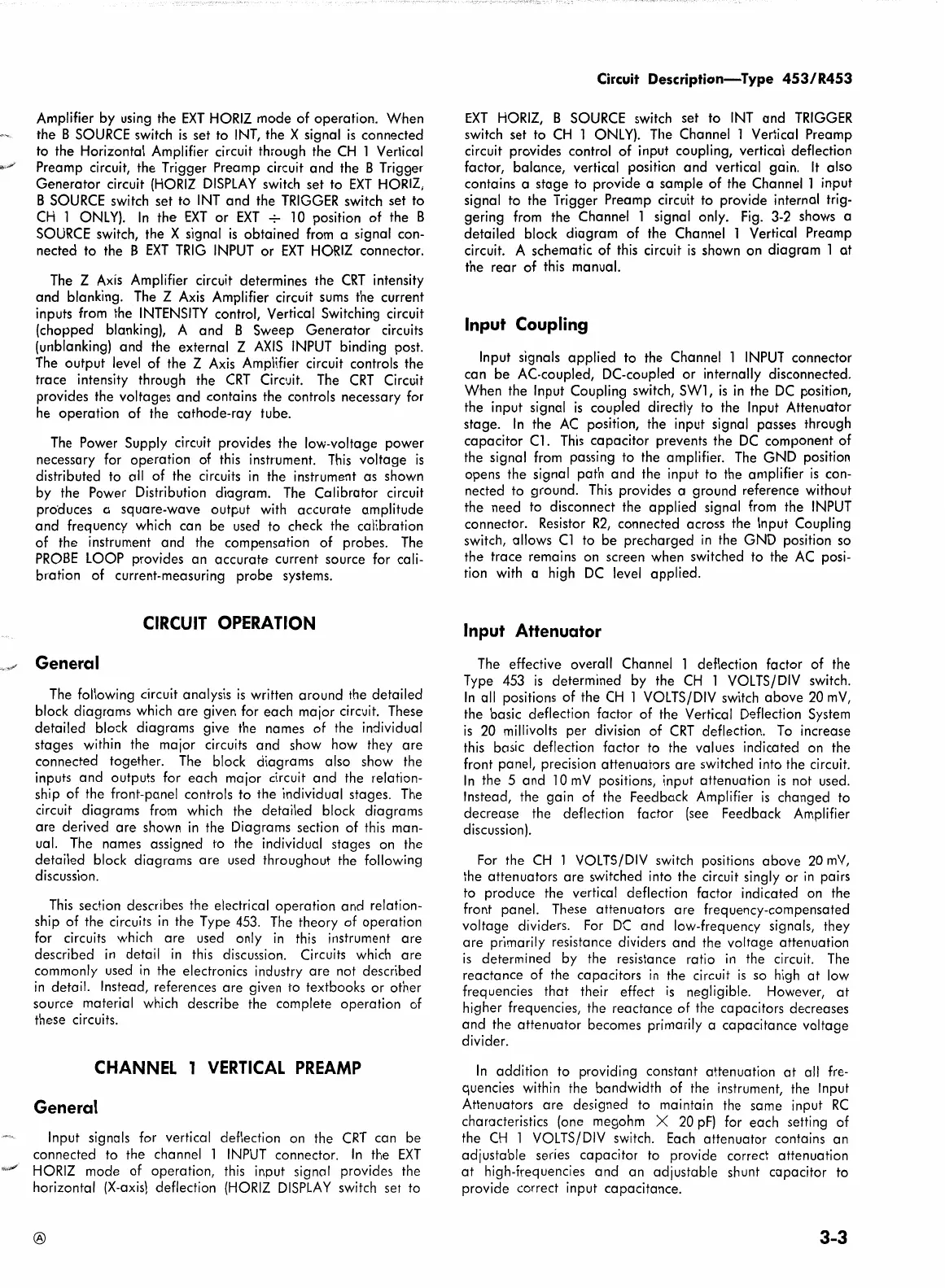Amplifier by
using
the
EXT
HORIZ
mode of operation. When
the B
SOURCE
switch
is
set to
INT,
the X signal
is
connected
to the Horizontal Amplifier circuit through the
CH
l Vertical
Preamp circuit, the Trigger Preamp circuit and the B Trigger
Generator circuit
(HORIZ
DISPLAY
switch set to
EXT
HORIZ,
B
SOURCE
switch set to
INT
and the
TRIGGER
switch set to
CH
l
ONLY).
In
the
EXT
or
EXT
+ l 0 position of the B
SOURCE
switch, the X signal
is
obtained
from
a signal con-
nected to the B
EXT
TRIG
INPUT
or
EXT
HORIZ
connector.
The
Z
Axis
Amplifier circuit determines the
CRT
intensity
and blanking.
The
Z
Axis
Amplifier circuit
sums
the current
inputs
from
the
INTENSITY
control, Vertical Switching circuit
(chopped blanking), A and B Sweep Generator circuits
(unblanking) and the external Z
AXIS
INPUT
binding post.
The
output
level
of the Z
Axis
Amplifier circuit controls the
trace intensity through the
CRT
Circuit.
The
CRT
Circuit
provides the voltages and contains the controls necessary for
he
operation of the cathode-ray tube.
The
Power Supply circuit provides the low-voltage power
necessary for operation of
this
instrument.
This
voltage
is
distributed to all of the circuits
in
the instrument as shown
by the Power Distribution diagram.
The
Calibrator circuit
pro"duces
a square-wave output
with
accurate amplitude
and frequency
which
can be
used
to check the calibration
of the instrument and the compensation of probes.
The
PROBE
LOOP
provides an accurate current source for cali-
bration of current-measuring probe systems.
CIRCUIT OPERATION
General
The
following circuit analysis
is
written around the detailed
block diagrams which are given for each major circuit. These
detailed block diagrams give the names of the individual
stages within the major circuits and show how they
are
connected together.
The
block diagrams also show the
inputs and outputs for each major circuit and the relation-
ship of the front-panel controls to the individual stages.
The
circuit diagrams
from
which the detailed block diagrams
are derived
are
shown
in
the Diagrams section of
this
man-
ual.
The
names assigned
to
the individual stages
on
the
detailed block diagrams are
used
throughout the following
discussion.
This
section describes the electrical operation and relation-
ship of the circuits
in
the Type
453.
The
theory of operation
for circuits which are used only
in
this
instrument are
described
in
detail
in
this
discussion. Circuits which are
commonly used
in
the electronics industry are not described
in
detail. Instead, references are given
to
textbooks or other
source material which describe the complete operation of
these circuits.
CHANNEL 1
VERTICAL
PREAMP
General
Input signals for vertical deflection
on
the
CRT
can be
connected to the channel l
INPUT
connector.
In
the
EXT
HORIZ
mode of operation,
this
input signal provides the
horizontal
(X-axis)
deflection
(HORIZ
DISPLAY
switch set
to
®
Circuit
Description-Type
453/R453
EXT
HORIZ,
B
SOURCE
switch set to
INT
and
TRIGGER
switch set to
CH
l
ONLY).
The
Channel l Vertical Preamp
circuit provides control of input coupling, vertical deflection
factor, balance, vertical position and vertical gain.
It
also
contains a stage to provide a sample of the Channel l input
signal to the Trigger Preamp circuit to provide internal trig-
gering
from
the Channel 1 signal only.
Fig.
3-2
shows a
detailed block diagram of the Channel 1 Vertical Preamp
circuit. A schematic of
this
circuit
is
shown on diagram 1
at
the rear of
this
manual.
Input Coupling
Input signals applied to the Channel 1
INPUT
connector
can be AC-coupled, DC-coupled or internally disconnected.
When the Input Coupling switch, SWl,
is
in
the
DC
position,
the input signal
is
coupled directly to the Input Attenuator
stage.
In
the
AC
position, the input signal passes through
capacitor Cl.
This
capacitor prevents the
DC
component of
the signal
from
passing to the amplifier.
The
GND position
opens the signal path and the input
to
the amplifier
is
con-
nected to ground.
This
provides a ground reference without
the need to disconnect the applied signal
from
the
INPUT
connector. Resistor
R2,
connected across the Input Coupling
switch, allows
Cl
to be precharged
in
the GND position
so
the trace remains
on
screen when switched to the
AC
posi-
tion
with
a high
DC
level
applied.
Input Attenuator
The
effective overall Channel 1 deflection factor of the
Type
453
is
determined by the
CH
l
VOLTS/DIV
switch.
In
all positions of the
CH
l
VOLTS/DIV
switch above
20
mV,
the basic deflection factor of the Vertical Deflection
System
is
20
millivolts
per division of
CRT
deflection.
To
increase
this
basic deflection factor
to
the values indicated
on
the
front panel, precision attenuators are switched into the circuit.
In
the 5 and l 0
mV
positions, input attenuation
is
not used.
Instead, the gain of the Feedback Amplifier
is
changed
to
decrease the deflection factor
(see
Feedback Amplifier
discussion}.
For
the
CH
1
VOLTS/DIV
switch positions above
20
mV,
the attenuators are switched into the circuit singly or
in
pairs
to produce the vertical deflection factor indicated
on
the
front panel. These attenuators are frequency-compensated
voltage dividers.
For
DC
and low-frequency signals, they
are primarily resistance dividers and the voltage attenuation
is
determined by the resistance ratio
in
the circuit.
The
reactance
of
the capacitors
in
the circuit
is
so
high
at
low
frequencies that their effect
is
negligible. However,
at
higher frequencies, the reactance of the capacitors decreases
and the attenuator becomes primarily a capacitance voltage
divider.
In
addition to providing constant attenuation
at
all
fre-
quencies within the bandwidth of the instrument, the Input
Attenuators
are
designed
to
maintain the same input
RC
characteristics (one megohm X
20
pF}
for each setting of
the
CH
1
VOLTS/DIV
switch.
Each
attenuator contains an
adjustable series capacitor
to
provide correct attenuation
at
high-frequencies and an adjustable shunt capacitor to
provide correct input capacitance.
3-3

